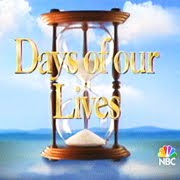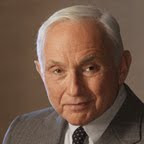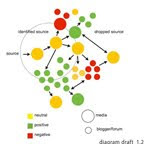
Chris Brogan says the more you post, the more traffic you get. Julien Smith sees it differently. He says writing fewer posts can drive more traffic.
Considering they co-authored the book Trust Agents together, some people might assume they'd be on the same page about this topic. But they aren't. They're both a little bit right, and both a whole lot wrong. They're writing about what works for them.
How often should you post on a blog to get more traffic?
It's the wrong question because it depends. It depends on you. It depends on the subject. It depends on the audience. It depends on the field.
It's almost like buying a hat. It depends on you. It depends on the hat. It depends on where you want to wear it. And while you can try on other people's hats as much as you like, none of them will fit until you find one that fits you. Even then, it still won't fit for every occasion or forever. And sometimes, somebody might already be wearing the hat you fancy.
In tracking about 250 blogs, daily, for almost a year, our team had all sorts of reactions sifting through the reader every day. Some daily authors kept our interest. Some daily authors bored us to tears. And some daily authors made us hate social media.
Conversely, some occasional authors made us wish for more. Some we forgot about completely. And others, well, let's just say we wondered what they would write about if they didn't write about what other people had already written about.
Three truths about frequency and blog authors.
 1. Consistency. No matter what you decide — daily or weekly or in between — consistency matters. Not only does it matter in terms of frequency, but for quality as well. Daily authors do have an advantage in that readers might forgive a few flat posts as long as they nail at least one a week or every other week. However, consistently posting on the topic du jour or self-promoting drivel becomes maddening to read. Inconsistent bloggers also have it harder; they practically start from square one with every post. Nobody knows them well enough to know whether they wear a hat or not.
1. Consistency. No matter what you decide — daily or weekly or in between — consistency matters. Not only does it matter in terms of frequency, but for quality as well. Daily authors do have an advantage in that readers might forgive a few flat posts as long as they nail at least one a week or every other week. However, consistently posting on the topic du jour or self-promoting drivel becomes maddening to read. Inconsistent bloggers also have it harder; they practically start from square one with every post. Nobody knows them well enough to know whether they wear a hat or not.2. Clarity. Not all that different than a batting streak in baseball, authors ebb and flow. In looking at the ten authors who made the top five in at least quarter, all of them had short, sustained bursts of high quality content — two or three superior posts within days of each other. After each burst, quality waned as they caught their breath or took a break. The lesson is one of humanity. Nobody is such a genius that they can write a riveting post two or three times a day. Einstein couldn't even fit into a hat like that.
3. Comments. Most social media measures that include comment counts are baloney. Sure, comments give authors insight, but there is context to consider. Asking the same audience to leave insightful, conversational comments day in and day out just isn't going to happen. It would be just like expecting people to compliment your hat every day. Besides, we found even the sloppiest controversial posts consistently outperform high-quality educational posts in comments, especially if they are published daily. We also found popular blogs draw more comments because people want the author's attention or the attention of the author's readers. People who say "best post ever" rarely ever mean it.
A quick look at the top of the scale.
 The top three most picked authors included Valeria Maltoni (red), Geoff Livingston (purple), and Ike Pigott (green). All three have different publishing styles, ranging from daily to semi-consistently, to inconsistently. They also have different writing styles, ranging from strategically educational to timely provocative to wildly well crafted. About the only thing in common outside of a few shared ideas is that they all know what fits them as an author.
The top three most picked authors included Valeria Maltoni (red), Geoff Livingston (purple), and Ike Pigott (green). All three have different publishing styles, ranging from daily to semi-consistently, to inconsistently. They also have different writing styles, ranging from strategically educational to timely provocative to wildly well crafted. About the only thing in common outside of a few shared ideas is that they all know what fits them as an author. Measurements at a glance overwhelmingly favor Maltoni, with Livingston drawing more comments and shares, and Pigott having the smallest bounce rate and longest time on site. However, on any given week, each of them can out "traffic" the other. The same can be said about the quality of the content they provide.
While Maltoni might appear to deliver more quality, the graph doesn't account for the ratio of picks to published. For example, Pigott published significantly less and Livingston took several breaks during the year. More important than trying to decide which offers more quality posts is to note that higher peaks are followed by deeper valleys across all three.
For methodology, the scale awarded five points for each fresh pick post, diminishing them at a rate of one for each week following. In other words, one post would be scored a "5" and then drop to a "4" on the following week. The diminishing number would be added to any fresh pick that it overlapped.
A quick look at another section of the scale.
 The next grouping is more indicative of most quality-oriented bloggers. It includes Lee Odden (purple), Jason Falls (blue), Adam Singer (green), and Ian Lurie (red). It uses the same methodology as above.
The next grouping is more indicative of most quality-oriented bloggers. It includes Lee Odden (purple), Jason Falls (blue), Adam Singer (green), and Ian Lurie (red). It uses the same methodology as above. Basically, whether authors published daily or not, the best authors tended to deliver about one outstanding post every four to five weeks regardless of how often they publish. That doesn't mean the rest of the content is fluff. It simply means that their best content — most original, engaging, and inspired — comes at a pace of once a month. In comparison, about half of the fresh pick authors deliver one exceptional post every three months. The greater majority, including those that weren't tracked by the experiment, only do so once or twice a year.
As an additional point of interest, we began covering Lurie in the second quarter. Odden seemed to publish more in the beginning of the year than at the end of the year. Also, while it was too complicated to show three more bloggers on the graph, these patterns fit the other three as well: Danny Brown, Maria Reyes McDavis, and Bob Conrad.
So what should we consider in deciding content frequency?
 It depends on your ability to deliver consistent high quality content within whatever schedule you set. It depends on the audience, and how much about your area of specialty they can digest. It depends on the subject matter because the more specialized it becomes, there are naturally fewer topics to write about. It may even depend on the saturation of the field.
It depends on your ability to deliver consistent high quality content within whatever schedule you set. It depends on the audience, and how much about your area of specialty they can digest. It depends on the subject matter because the more specialized it becomes, there are naturally fewer topics to write about. It may even depend on the saturation of the field. Conversely, Brogan and Seth Godin are very general in their writing. While that means their groundbreaking posts are even further and fewer between in favor of a high frequency fortune cookie styling, it's the derby that fits for them. What's more important is to determine what hat might be a fit for you.
This is the first lesson from the Fresh Content experiment, which tracked 250 blogs for almost a year. The experiment focused on the quality of the content and not the perceived popularity of the authors.






































